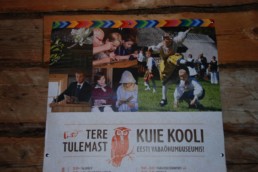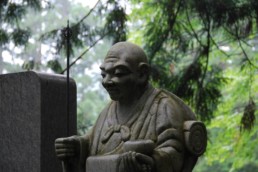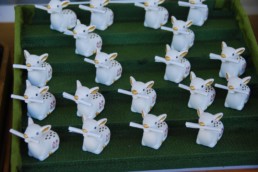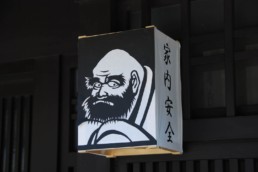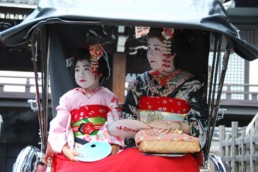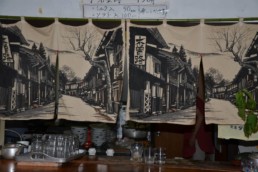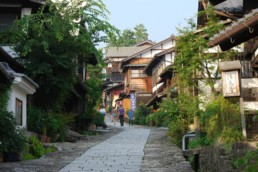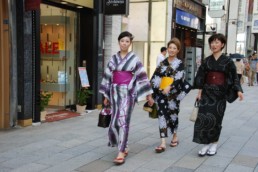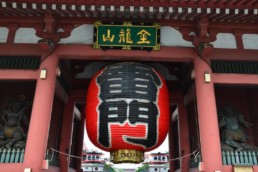It is our last breakfast on the 20th floor of our hotel, overlooking Tokyo’s skyline. Dragging our heavy suitcases, we depart for the Yoyogi station on the Yamanote line, and head for the gigantic Tokyo station. We are to board the famous Shinkansen speed train which will take us to Ueda. What a fabulous train, this Shinkansen! As it enters the station smoothly and silently, with its long white muzzle, it looks really powerful and impressive. Captivated by the spectacle, we forget to take a picture! Damn! The train is very precisely on time. All trains always are right on schedule in Japan. The train system runs like clockwork throughout the country, even though it is managed by different companies.
We line up with the Japanese travelers in the queue to wait patiently for our turn to board the train. This almost-military discipline is indispensable in a megalopolis of 30 million people, and curiously, we are a lot less stressed out than in the Parisian train stations at peak hours.
By now we feel at ease in the Japanese train stations and we master the routine. We watch the screens which display information in turn in Japanese and in English (we still prefer to rely on the English version), we show our JR passes at the gate before the platform, we make sure to walk thru the right lane so as to avoid triggering the alarm bell like we did the first time! There are 5 of us, and with our large suitcases, we are a clumsy crew. Once on the platform, we look out for the unreserved cars (this is very convenient, actually; as we take different trains to travel around the country, we do not have to bother making reservations each time), and we line up at the clearly-marked sign. We get on board with our heavy suitcases, which is not too bad because there is no step between the train and the platform (thumbs up to the planners). We get settled in our seats and enjoy the scenery and the landscapes which we pass by along the ride.
As the train leaves Tokyo, once again we are struck by how far out one has to go before the first trees and the first rice paddies appear in sight.
At Ueda, we get off for our connection on the Ueda Kotsu private line heading for Bessho-Onsen. At the Shinkansen station, employees on duty show us the direction to go and purchase tickets for Bessho-Onsen, as it is actually in another station just outside. Wearing white gloves and impeccable uniforms, employees of the train companies are always very eager to provide assistance. They very rarely speak English, but they are patient, very polite, and they try their best effort!
In the train which takes us to Bessho-Onsen, we watch the elaborate gestures of the train conductor at each checkpoint along the tracks, pointing to the signs on the poles, then checking the time, and then looking up the corresponding entry on the trip schedule. At a small station about halfway, a changing of conductors calls for a short yet formal ceremony on the platform which reminds me of the changing of the guards at Buckingham Palace!
The train is made of just a few cars, and it rides slowly, stopping at every small country station. Along with a few Japanese passengers, there are only 2 other tourists with us in the train. The atmosphere is quite different from Tokyo, you could say! Next stop is Bessho-Onsen. The station is cute and welcoming. We love the place already!
To reach the Kashiwaya Houten ryokan, it is quite simple on the map: you keep walking on the main street from the station. But in this month of August 2013, it is very hot, and dragging our monster suitcases, we look for every tiny piece of shade we can find along the way. Needless to say, our little caravan does not go unnoticed in this small village, and several employees of the ryokan come down running (really) to greet us and help us with our luggage for the last yards to our destination. Sweet. We are hot and sweaty.
We take off our shoes, of course, and we are treated to a little welcome ritual: green tea and red-bean cakes neatly set on beautiful, tiny plates covered with Japanese paper. Our hosts inform us that dinner will be served at 7:00 pm. We reserve the hotel’s private hot bath for 6:00 pm, and to our astonishment, our hosts suggest we select the yukatas which we will be wearing tonight for dinner. To that end, we are presented with a wide collection of beautiful silk yukatas to choose from. What a treat!
Yukatas vary from the simple kind, made of cotton, for everyday use, like bathrobe, to sophisticated ones, very elegantly designed, made of silk, for more formal occasions, such as dinner with guests, visits to a temple, etc. So yukatas vary widely in price. They are very popular, and throughout the country, Japanese people, women mostly, wear yukatas very often. Now, yukatas should not be confused with kimonos, which are extremely sophisticated costumes reserved for very special occasions such as a wedding ceremony or a funeral. Kimonos require an elaborate, impeccable hairdo, as well as sophisticated, Japanese-style make-up. Of course, kimonos are also well known as the required costumes for the famous, mysterious geishas. Kimonos are extremely expensive, easily into the several thousands of dollars.
Choosing our yukatas for tonight is hard. Francois cannot suppress an amused smile on his face, but we girls are excited, and that’s great! We finally each choose a yukata with an assorted belt. Our host will keep them and bring them to us after the hot bath. We are now ready to go out for lunch. At our request, the ryokan manager recommends a soba restaurant in the village, not too far from the ryokan. Sobas are long buckwheat noodles which can be consumed hot or cold, plain or with meat or vegetables in a broth.
So we get on our way to look for the soba restaurant. We walk down the main street and then turn into an adjacent street which takes us to a small pathway. The restaurant actually looks more like a private home rather than an establishment open to the public. But it is indeed the place we are looking for, and a friendly lady, sweating like us, greets us at the front door. Unexpectedly she speaks a good English, but so sorry, the restaurant at this time has soba left only for 2 guests. She feels so apologetic that she offers to drive us to another restaurant in town! Incredible! We are a bit troubled by such kindness, and not sure how to react, we stand still at the front door. After a moment, the lady comes back from the kitchen and informs us that she can prepare tempuras for 3 to go along with the soba leftover. This sounds great to us! We immediately accept, the place looks so charming. Shoes off. We enter a typical Japanese restaurant room, with low tables, cushions, and no chairs. Two Japanese families are finishing their meals. We seat down, quietly, trying our best to fit into the scene. Service is discreet and efficient, the meal is delicious and copious. This lunch exceeds our expectation by far! Our stay in Bessho-Onsen is off to a fantastic start.
We spend the afternoon visiting the temples of Bessho-Onsen.
Bessho-Onsen is a very small town spread around a main street which heads up towards the mountain. This is the Japanese Alps. There is a lot of snow in the winter.
The hot springs in Bessho-Onsen date back to the Heian period (794-1185). In the Kamakura period (1185-1333), the place became the summer residence of the shogun Hojo. It is a major religious center, and many temples were established here in those ancient times.
We visit a good number of these temples, feeling the quietness of the surroundings, admiring the statues and the steles.
We pay particular attention to the Anraku-ji pagoda, which is classified as a National treasure. It is the very last octagonal pagoda left standing in Japan. A unique monument.
Later we visit the Chûzen-ji and the Zenzan-ji temples, where we encounter a few Japanese families most likely on some pilgrimage visits. They light up incense sticks, say their prayers, and pay their respect in these quiet, sacred places.
From our different visits and various discussions, we grasp that it is commonplace for Japanese people to follow different religious faiths at the same time, mainly Shintoism and Buddhism. Shintoism is the most ancient religion in Japan. It is an animist and shamanist faith based on the worship of the spirits which inhabit sacred places. Shintoism was the official religion of the Japanese state, but religion was separated from the state in Japan in the aftermath of the 2nd world war as part of the settlement with the USA and with the new constitution. Buddhism was introduced in Japan in the middle of the 6th century, coming from Korea, and it became an official religion when Prince Shôtoku (573-622) adopted it himself.
We will talk again about religion later. For now we need to start heading back to our ryokan. On the way, we stop at various little stores on the main street in the village. We have a sudden craving for European biscuits (red-bean cakes taste good, yes, yes, absolutely, but after a while, you know…). We decide anyway to buy a box of traditional Japanese cakes. A very friendly storekeeper serves us, and to our surprise, spontaneously gives us a price discount, laughing and bowing. We make sure to bow back to thank him. Residents of this town are all incredibly friendly and welcoming. We love Bessho-Onsen!
It is now time to go back and prepare for the hot bath, the fitting of the yukatas, and then dinner….A great program for the evening. Taking a hot bath in Japan is a very special experience. First, take a shower, and once your body is clean, fully naked, step slowly into the hot bath. The water is so hot that it is almost painful at first. But then, little by little, as you get used to the temperature, it becomes a very relaxing, pleasurable moment. The water from the Bessho-Onsen hot springs is really hot and very sulfurous. It is good for the body joints and the skin, we are told. After a while, and before we change state from solid to liquid, we step outside the bath, and take a cold shower to cool off. We put on our yukatas, including Francois who tries to look like a samurai. We start with a tasting of various kinds of sake, from sweet to dry, and then, it is dinner time. A set of 11 dishes is served, all delicious. Even though the dishes all come in small servings, it is a lot of food for us! Definitely an exquisite evening.



















